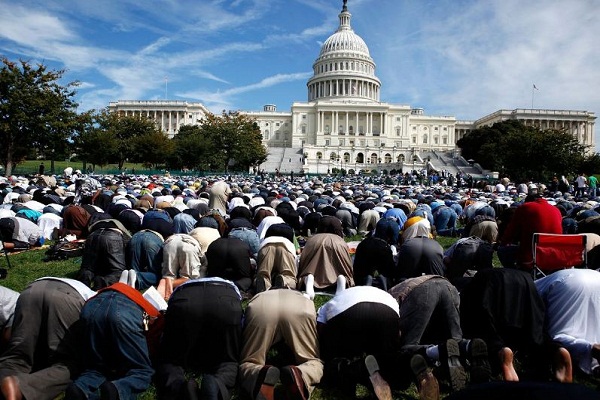Islam in America came from slave immigrants who were sent to America in several waves. Islam is thought to have entered the Americas long before Columbus discovered this continent on October 21, 1492.
Quoted from the Class XII Islamic Cultural History module published by the Ministry of Education and Culture in 2019, in several historical records, Islam is estimated to have been embraced by several Indian tribes such as the Iroquois and Algonquin tribes since 900 AD.
However, there is also another version that states that Islam in America entered the 16th century. At that time it was known that there were the first two Muslims in North America named Estevanico and Azamor. Estevanico is a Berber from North Africa. He traveled to Arizona and New Mexico from the Kingdom of Spain. And, Estevanico came to America as a slave to Spanish explorers in the 16th century.
In the same century, many slaves from South Africa were sent to North America in 1520. The number is approximately 500 thousand souls or approximately 4.4 percent of the total slaves which reached 11,328,000 people. Approximately 200 thousand souls of slaves sent to North America on average came from countries that already know Islam. The presence of Muslims in America is estimated to have increased between 1875 and 1912, as the first wave.
They are immigrants from rural areas in Syria, Jordan, Palestine, and Israel. Formerly the country was part of Greater Syria under the control of the Ottoman Caliphate (Ottoman). After this caliphate collapsed in World War I (World War I), there was a second wave of migration of Middle Eastern Muslims to America, which was also the start of Western colonialism in the Middle East. In general, historical researchers are of the view that the arrival of immigrants to America through several different periods or waves is what makes the spread of Islam in the Americas expand.
The Development of Islam in the United States
Muslim migrants have a direct and indirect impact on life in the United States. Subhan Khalik in the History of the Development of Islam in America (Jurnal Al Daulah Vol. 4 No. 2 December 2015) writes that the interaction of natives with Muslim migrants affects American demographic factors, politics, economy, and trade. Although the United States is a country that adheres to liberal and secular democracy, it provides religious freedom for the people. Initially, Islam was judged to be the religion of Middle Eastern or Pakistani immigrants in several cities.
But, gradually, Islam is increasingly showing its existence. One of them emerged a force called Black Moslem with a character named Elijah Muhamad in the City of Chicago. As the name implies, the people in it are mostly black Muslims. This group demands that there are equal rights regardless of skin color, as is the case with the teachings of Islam. Black Moslem has a wide influence.
Many figures in the US then converted to Islam. Among them are the accomplished orator Malcolm (Al Haji Malik Al Sabah), and former boxer Cassius Clay who later changed his name to Muhammad Ali. Both Ali and Malik helped preach Islam in the US. After the death of Muhammad Ali, his son, Wallace Muhammad, held the next baton. He held the Nation of Islam organization which later changed its name to the World Community of Islam in the West in 1976. This name change was to reach a wider range of da’wah. Under his leadership, the development of Islam progressed.
The anti-racial da’wah that he carried out was by Islamic teachings, knocking many people learning this religion who do not recognize differences in skin color to race. On April 30, 1980, the name World Community of Islam in the West was changed back to American Muslim Mission (AMM) to strengthen the organization’s mission. Meanwhile, Islamic organizations and institutions are increasingly scattered in the US over time. In the city of Chicago stood the Islamic Institute. This building is a project of the International Islamic Conference Organization which is based in Jeddah. This building is equipped with a library, lecture hall, hall, and other facilities for studying Islam. The Islamic Center is also found in Los Angeles as a center for lectures and other Islamic activities. Meanwhile, there is the Islamic Society of North America (ISNA) in Mansfield, Indianapolis, USA.
This organization is a center for Islamic studies which has a mosque with the capacity to accommodate up to 1,000 worshipers. ISNA also coordinates with student organizations such as the Muslim Student Association (MSA), Muslim doctor organizations, and Muslim scholars. MSA is known to have book publishing, namely MSA Islamic Book Service, recording studio, producing tv films, and printing. One of the media published is Al-Ijtihad (unity) magazine. Islam in America has, after a long time, acquired a special place in local society. The Muslims there are considered to have made a major contribution to the progress of development. Muslim leaders also get a chance to occupy positions in the ranks of the United States. For example, Keith Ellison was the first Muslim congressman to be sworn in in America.
He became the representative of Minnesota’s 5th district. Keith was sworn in using Thomas Jefferson’s copy of the Holy Quran. Even though Muslims in the US were under serious pressure after the attacks on the WTC twin towers on September 11, 2001, it didn’t necessarily stop the development of Islam. Shamsi Ali as the Grand Imam of the Islamic Center in New York at that time, as quoted by the Antara news page, said that there was a turning point after the incident.
Robert O Blake Jr, who served as Ambassador Extraordinary and Plenipotentiary of the United States to Indonesia, stated on July 9, 2015, that Islam is growing very rapidly in the United States. One of the fastest-growing areas of Islam is in the state of Texas. In the US region, Islam is the second-largest religion that is accepted and respected.
